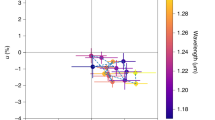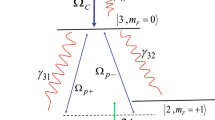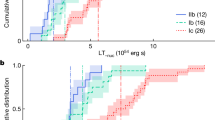Abstract
IF a type I supernova is the result of the explosion of a star with a degenerate nucleus (see, for example, Baglin1) it is likely that a large magnetic field will be present in the radiating region for a short period following the outburst. Depending on the emission process a sufficiently large field could produce a measurable optical circular polarization. For example, for bremsstrahlung in an optically thick but very dilute plasma in an ordered magnetic field of H gauss, the fractional circular polarization in the optical continuum is q ∼ 10−9 H (see refs. 2 and 3). If the degenerate progenitor of the supernova is entirely destroyed in the explosion, conservation of magnetic flux dictates that q would reach the limit of detectability (qLIM∼3 × 10−6 : HLIM∼3,000 G) in only 20 s for either a white dwarf (initial radius r0∼109 cm, initial field H0∼106 G) or a neutron star (r0∼106 cm, H0∼1012 G) assuming an expansion velocity of 104 km s−1. If a sizable fragment survives, however, a measurable polarization might be seen for a much longer period. For synchrotron emission smaller fields can produce a detectable polarization. According to Legg and Westfold4 a hypothetical field H∼106 G in the Crab nebula would produce q∼10% in the visible: since q ∝ H½ a polarization qLIM∼3 × 10−6 corresponds to HLIM ∼ 10−3 G. However, the precise conditions strongly influence5,6 the relations between q and H; the interpretation would therefore be uncertain even if this mechanism were shown to be dominant. The influence of radiative transfer in the dense layers near the star and of a possible fluorescence emission in the outer layers of the shell7 would make the interpretation for the synchrotron process even more difficult.
This is a preview of subscription content, access via your institution
Access options
Subscribe to this journal
Receive 51 print issues and online access
$199.00 per year
only $3.90 per issue
Buy this article
- Purchase on SpringerLink
- Instant access to full article PDF
Prices may be subject to local taxes which are calculated during checkout
Similar content being viewed by others
References
Baglin, A., Astrophys. Lett., 1, 143 (1968).
Kemp, J. C., Astrophys. J., 162, 169 (1970).
Gnedin, Y. N., Dolginov, A. Z., and Silant'ev, N. A., Zh. Eksper i Teoret. Fiz, 59, 865 (1970) (English transl., Soviet Phys.—JETP, 32, 472 (1971)).
Legg, M., and Westfold, K., Astrophys. J., 154, 499 (1968).
Pacholczyk, A., and Swihart, T., Astrophys. J., 161, 415 (1970).
Melrose, D. B., Astrophys. Lett., 8, 35 (1971).
Morrison, P., and Sartori, L., Astrophys. J., 158, 541 (1969).
Kowal, C. T., IAU Circular No. 2406 (1972).
Herbig, G. H., IAU Circular No. 2408 (1972).
Stephenson, C. B., IAU Circular No. 2408 (1972).
Serkowski, K., Astrophys. J., 160, 1083 (1970).
Kemp, J. C., Astrophys. J., 175, L35 (1972).
Author information
Authors and Affiliations
Rights and permissions
About this article
Cite this article
WOLSTENCROFT, R., KEMP, J. Optical Polarization of the Supernova in NGC 5253. Nature 238, 452 (1972). https://doi.org/10.1038/238452a0
Received:
Issue date:
DOI: https://doi.org/10.1038/238452a0
This article is cited by
-
Polarization of the optical radiation of extragalactic objects
Astrophysics (1975)



